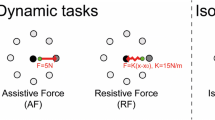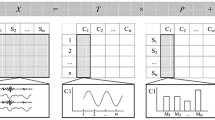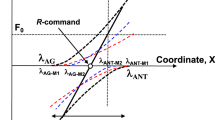Abstract
Generally the number of muscles acting across a joint exceeds the number of degrees of freedom available to the joint. This redundancy raises a problem regarding the ratio in which these muscles are activated during a particular motor task. In this paper we present a theory to explain the activation patterns of muscles used during voluntary and reflex induced contractions. The basic assumptions underlying the theory are that 1) coordination of muscles is based on synergistic muscle activities, 2) the synergisms involved satisfy certain transformations of muscle spindle signals to muscle activation signals and 3) muscle spindle output is proportional to the ratio of muscle stretch and muscle length in lengthening muscles, and is zero in shortening muscles. The theory is used to predict the recruitment threshold of motor units in six arm muscles during voluntary isometric contractions. All theoretical predictions are in reasonable agreement with the experimentally observed behavior of a large population of motor units within each muscle. However, within a single muscle sometimes motor-unit populations have been found to have different types of recruitment behavior. This deviating behavior is discussed in the light of the theory presented here.
Similar content being viewed by others
References
An KN, Hui FC, Morrey BE, Linscheid RL, Chao EY (1981) Muscles across the elbow joint: a biomechanical analysis. J Biomech 14:659–669
Bouisset S, Lestienne F (1976) Relative work of main agonists in elbow flexion. In: Kani PV (eds) International Series on Biomechanics 117, Proceedings of the 5th Congress of Biomechanics, Jyvastlylya, Sweden, University Park Press, Baltimore
Buchanan TS, Almdale DPJ, Lewis JL, Rymer WZ (1986) Characteristics of synergic relations during isometric contractions of human elbow muscles. J Neurophysiol 56:1225–1241
Cnockaert JC, Lensel G, Pertuzon E (1975) Relative contribution of individual muscles to the isometric contraction of a muscle group. J Biomech 8:191–197
Crowninshield RD (1978) Use of optimization techniques to predict muscle forces. J Biomech Engin 100:88–92
De Luca CJ, Forrest WJ (1973) Force analysis of individual muscles acting simultaneously on the shoulder joint during isometric abduction. J Biomech 6:385–393
Dul J, Townsend MA, Shiavi R, Johnson GE (1984) Muscular synergism. I. On criteria for load sharing between synergistic muscles. J Biomech 17:663–673
Fick R (1911) Handbuch der Anatomie und Mechanik der Gelenke, III. Spezielle Gelenk- und Muskelmechanik. Fischer, Jena, pp 274–332
Fritz N (1981) Ia-synergismus an der vorderen Extremität der Katze. Thesis. Biology Faculty of the Ludwig-Maximilian-Universität München
Gielen CCAM, van Zuylen EJ (1986) Coordination of forearm muscles during flexion and supination: application of the tensor analysis approach. Neuroscience 17:527–539
Gielen CCAM, Ramaekers L, van Zuylen EJ (1988) Medium latency stretch reflexes as coordinated functional responses. J Physiol 407:275–292
Jongen HAH, Denier van der Gon JJ, Gielen CCAM (1989) Inhomogeneous activation of the motoneurone pool as revealed by co-contraction of antagonistic human arm muscles. Exp Brain Res (in press)
Jørgensen K, Bankov S (1971) Maximum strength of elbow flexors with pronated and supinated forearm. In: Medicine and Sport 6: Biomechanics 11:174–180. Karger, Basel
Lohman AHM (1976) Vorm en beweging: leerboek van het bewegingsapparaat van de mens. Deel II: platen. Bohn, Scheltma en Hoeksema, Utrecht
Pellionisz A, Llinás R (1980) Tensorial approach to the geometry of brain functionfc: cerebellar coordination via a metric tensor. Neuroscience 5:1125–1136
Pellionisz A, Llinás R (1984) Coordination: a vector-matrix description of transformation of overcomplete CNS coordinates and a tensorial solution using the Moore-Penrose generalised inverse. J Theor Biol 110:353–375
Pellionisz A, Llinás R (1985) Tensor network theory of the metaorganisation of functional geometries in the central nervous system. Neuroscience 16:245–273
Prochazka A (1981) Muscle spindle function during normal movement. In: Porter R (ed) Neurophysiology IV. Int Rev Physiol 25, University Park Press, Baltimore
Rack PMH, Ross HF (1984) The tendon of flexor pollicis longus: its effects on the muscular control of force and position at the human thumb. J Physiol 351:99–110
Sobotta J, Becher H (1972) Atlas der Anatomie des Menschen. Band I: Regionen, Knochen, Bänder, Gelenke und Muskeln des menschlichen Körpers. Urban & Schwarzenberg, München
Stuart GJ, Rymer WZ, Schotland JL (1986) Characteristics of reflex excitation in close synergistic muscles evoked by muscle vibration. Exp Brain Res 65:127–134
Ter Haar Romeny BM, Denier van der Gon JJ, Gielen CCAM (1984) Relation between location of a motor unit in the human biceps brachii and its critical firing levels for different tasks. Exp Neurol 85:631–650
Zuylen EJ van, Gielen CCAM, Denier van der Gon JJ (1988a) Coordination and inhomogeneous activation of human arm muscles during isometric torques. J Neurophysiol 60:1523–1548
Zuylen EJ van, Velzen A van, Denier van der Gon JJ (1988b) A biomechanical model for flexion torques of human arm muscles as a function of elbow angle. J Biomech 21:183–190
Voss H (1970) Tabelle der absoluten und relativen Muskelspin-delzahlen der menschlichen Skelettmuskulator. Anat Anz 129:562–572
Wei JY, Simon S, Randic M, Burgess PR (1986) Joint angle signaling by muscle spindle receptors. Brain Res 370:108–118
Author information
Authors and Affiliations
Rights and permissions
About this article
Cite this article
Jongen, H.A.H., van der Gon, J.J.D. & Gielen, C.C.A.M. Activation of human arm muscles during flexion/extension and supination/pronation tasks: A theory on muscle coordination. Biol. Cybern. 61, 1–9 (1989). https://doi.org/10.1007/BF00204754
Received:
Issue Date:
DOI: https://doi.org/10.1007/BF00204754




